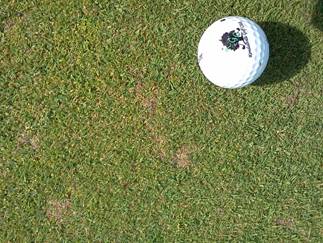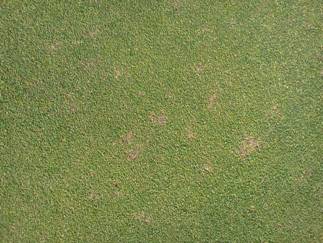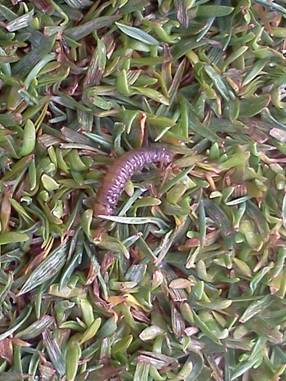Sod webworms may cause damage to closely mowed turfgrass early in the spring. Damage, similar to that depicted in the photos below, may be seen on golf tees and greens.
 The overwintered caterpillars become active when the temperatures warm up in the spring and begin to tunnel and feed. They are mostly active at night, so they often elude inspection. The absence of an obvious insect makes the diagnosis difficult, – but look for patches of close-cropped turf as well as the tiny trails or tunnels in the thatch. Often the soil (and sand topdressing material) in these trails is bound together with silken material to create a cover or cap, hence the name “webworm”. Along with the damage, these tunnels help provide evidence of sod webworm activity. A soap flush is a sure method of verifying sod webworm presence.
The overwintered caterpillars become active when the temperatures warm up in the spring and begin to tunnel and feed. They are mostly active at night, so they often elude inspection. The absence of an obvious insect makes the diagnosis difficult, – but look for patches of close-cropped turf as well as the tiny trails or tunnels in the thatch. Often the soil (and sand topdressing material) in these trails is bound together with silken material to create a cover or cap, hence the name “webworm”. Along with the damage, these tunnels help provide evidence of sod webworm activity. A soap flush is a sure method of verifying sod webworm presence.
To flush suspect areas, mix one full tablespoon of lemon scented Joy dishwashing liquid in two gallons of water and dispense the solution through a sprinkling can over 1 square meter of turf. It is best to mix the detergent into the proper amount of water by hand in order to minimize the formation of foam which can make it much more difficult to find emerging insects. Allow 10-15 minutes for the sod webworms to appear on the surface as it may take a while for the soapy water to penetrate the silk-lined tunnels these insects create.
 Healthy and vigorously growing turfgrass will often ‘outgrow’ damage from sod webworms. However, if the damage is unsightly and controls are warranted, use a pesticide that is labeled for sod webworms and apply at the recommended rates. Mach 2 and Conserve are both labeled for sod webworms as well as a host of conventional insecticides. Do not irrigate after application so that the insecticide stays on the blades and in the thatch where the webworms reside and feed.
Healthy and vigorously growing turfgrass will often ‘outgrow’ damage from sod webworms. However, if the damage is unsightly and controls are warranted, use a pesticide that is labeled for sod webworms and apply at the recommended rates. Mach 2 and Conserve are both labeled for sod webworms as well as a host of conventional insecticides. Do not irrigate after application so that the insecticide stays on the blades and in the thatch where the webworms reside and feed.
The following photo, taken two days after treatment shows the resulting dead larva.